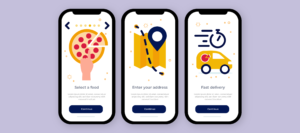The most important goal of any app development is user experience (UX). Apps that provide users with the best experience possible are usually appreciated and lovable. Such apps usually trend and go viral, and they are rated highly, achieving the intended purposes. As an app developer, your focus should include the critical UX issues, in addition to the functionalities of the app. Regardless of the functions designed for the app, the user experience should not be compromised. Ensure that the final product is useful and delightful to users.
To achieve this, it is essential to take advantage of the latest technologies provided by Google and Apple concerning the best practices in user experience (UX) and interface design. And talking about existing apps, they must be kept modern and updated regularly.
Whether you are a business or an organization, never treat your app like an orphan; do not have the mentality of launch and forget it if you want your app to fulfill its purposes. Several apps are on the app stores have been abandoned and their rating keeps plummeting, with negative reviews piling up.
Also Read: Effective Startup Strategy For Outsourcing App Development
If your app seems to be in oblivion, not showing up among the top apps in its category, you might be committing some crucial UX issues that leave users unhappy with your app and cause your app to lose credibility. If you want your app to stand up to the competition, appeal to users, and rank among the top apps in its category,
Below Are Certain UX Issues That You Must Address and Avoid
No Dark Mode Option
Most apps now incorporate the dark mode UI into their designs to provide users with an alternative to switch to whether at night or all the time. Many users prefer the dark mode. You could make your app more appealing to users by letting it support the dark mode option. More users would be interested in your app both on iOS and Android.
Failure to Support Text Scaling
It is a poor UX to users if your app does not support text scaling. Readers have different reading preferences based on their eye conditions. Making your app support text scaling will make your app delightful to use, as it can change the size of the text or font within the app. Keep in mind that font scaling is one of the accessibility guidelines for Android and iOS.
No Support for Long-press Gestures
Modern app development integrates long-press gestures to allow certain frequently taken actions to be made available much quicker without going through the step-by-step process. It is long-press on iOS and touch-and-hold on Android. If your app does not support long-press gestures, ensure to upgrade your app and improve your app’s user experience.
Embedded Web Stores for e-Commerce Apps
Integrating web stores into e-Commerce mobile apps is an outdated design that leaves users distraught. This feature is characterized by unnecessary navigational elements, frequent account sign-in, no wallet support, poor user interface (UI), and user experience (UX). Rather than embedding a web store into a supposed e-Commerce app, move your app to a native e-Commerce app that will offer a pleasant, seamless, and hassle-free experience to users.
No Support for Digital Wallets
Digital wallets are one of the latest technologies that your app should incorporate for ease of in-app transactions. It is easy to check out with digital Wallets. However, your app is unarguably lagging behind the competition if it does not support digital wallets. Google Pay and Apple Pay make apps a one-stop destination to checkout and make payments. These are the crucial UX issues for your app not to support the relevant digital wallets.
No Single Sign-on (SSO) Options
The hallmark of the mobile app is convenience. However, if it becomes tedious to sign up on your app – that new users have to provide their details, such as usernames, full names, and passwords, it will be a turnoff for many users. However, if you integrate the SSO, which allows users to “Sign In with Google” or “Sign In with Apple,” signing up with your app will be seamless, effortless, and provide an enhanced experience for your audience or users. This is a very crucial UX feature you should consider for your app.
No Biometric Authentication
Modern apps integrate biometric authentication just like SSO to ensure easy verification using face or fingerprint recognition. This makes signing into mobile apps easier. If your app does not support biometric authentication, your app users will possibly find competitors’ apps that do. Many users appreciate the convenience they enjoy using Apple’s FaceID on all apps that support the feature on iOS – they do not have to complete the verification processes always. Consequently, upgrade your app and make it more relevant and appealing to users.
Failure to Support Password Managers
As mentioned earlier, modern apps should use SSO technology. However, some apps that do not use the technology should at least support password managers to make signing in easier for users by automatically filling username and password fields. It would be disappointing if your app does not use SSO technology and does not support password managers. It will be frustrating for users to have to enter their login details each time they launch the app.
Two-factor Authentication Without Autofill
Several apps require two-factor authentication when logging in, which requires users to input the code sent via SMS message. However, it could be very difficult to input the code manually. Instead of manually entering the code received, it can be entered automatically through the autofill feature. Both Android and Apple support the autofill feature that makes the two-factor authentication seamless. It is, however, a UX issue to integrate two-factor authentication without including the autofill feature. Fix it as soon as possible to provide users with a pleasant experience.
The above are crucial UX issues that must be fixed as soon as possible to prevent your app from becoming uninteresting to users. You must fix all UX issues that your app may be having to maintain competitiveness and rank among the top apps in your category.
Meanwhile, there are other features that you can integrate into your app to enhance its UX, meet and exceed users’ expectations. Some of such features or functionalities include the following:
1. Widgets
2. App clips or instant apps
3. In-app review
4. Voice input
5. Second or third screen experience
Keep in mind to update your app regularly, leveraging the latest technologies. Fixing the crucial UX issues and integrating the features listed above into your app will make your app delightful to use and provide users with an amazing user experience (UX).




